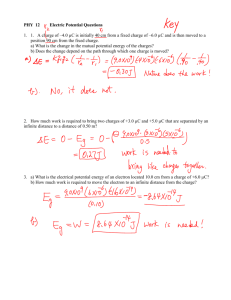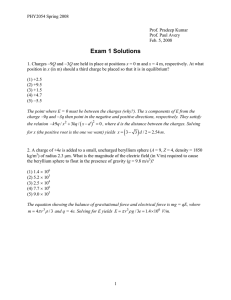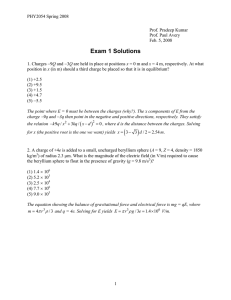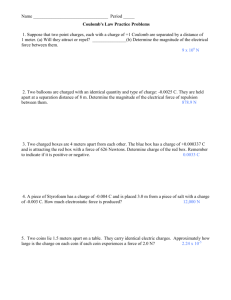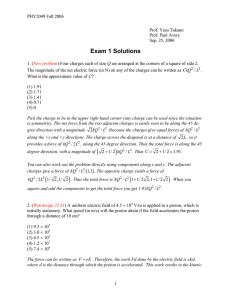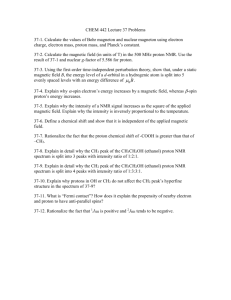Solution to Exam 1
advertisement
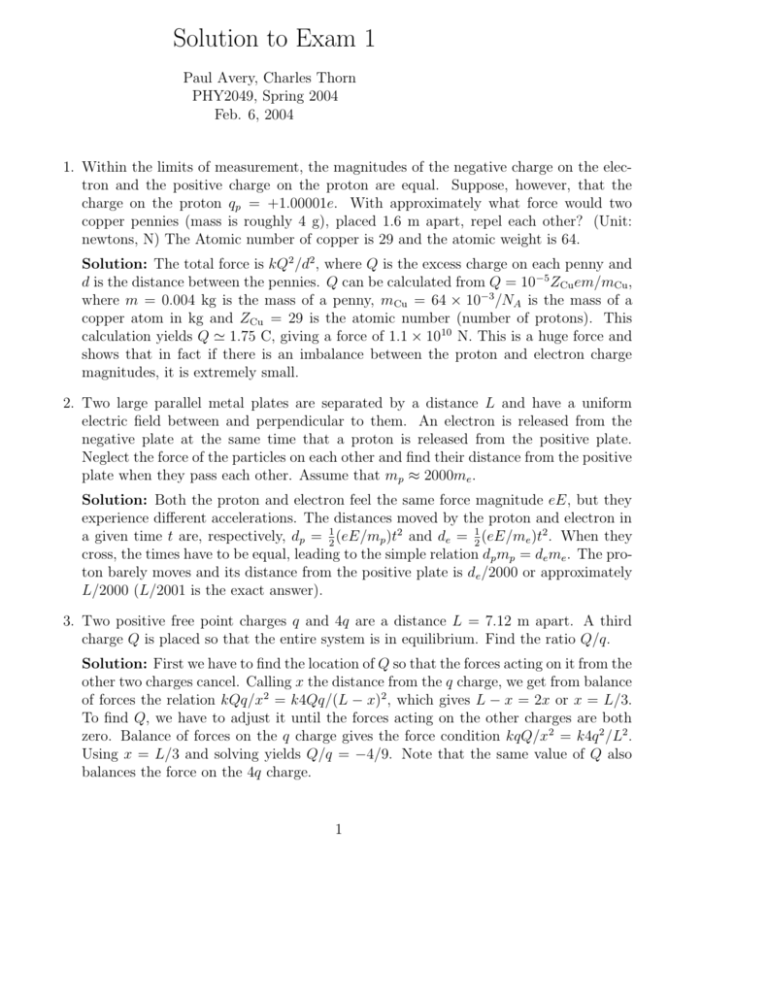
Solution to Exam 1 Paul Avery, Charles Thorn PHY2049, Spring 2004 Feb. 6, 2004 1. Within the limits of measurement, the magnitudes of the negative charge on the electron and the positive charge on the proton are equal. Suppose, however, that the charge on the proton qp = +1.00001e. With approximately what force would two copper pennies (mass is roughly 4 g), placed 1.6 m apart, repel each other? (Unit: newtons, N) The Atomic number of copper is 29 and the atomic weight is 64. Solution: The total force is kQ2 /d2 , where Q is the excess charge on each penny and d is the distance between the pennies. Q can be calculated from Q = 10−5 ZCu em/mCu , where m = 0.004 kg is the mass of a penny, mCu = 64 × 10−3 /NA is the mass of a copper atom in kg and ZCu = 29 is the atomic number (number of protons). This calculation yields Q ' 1.75 C, giving a force of 1.1 × 1010 N. This is a huge force and shows that in fact if there is an imbalance between the proton and electron charge magnitudes, it is extremely small. 2. Two large parallel metal plates are separated by a distance L and have a uniform electric field between and perpendicular to them. An electron is released from the negative plate at the same time that a proton is released from the positive plate. Neglect the force of the particles on each other and find their distance from the positive plate when they pass each other. Assume that mp ≈ 2000me . Solution: Both the proton and electron feel the same force magnitude eE, but they experience different accelerations. The distances moved by the proton and electron in a given time t are, respectively, dp = 12 (eE/mp )t2 and de = 21 (eE/me )t2 . When they cross, the times have to be equal, leading to the simple relation dp mp = de me . The proton barely moves and its distance from the positive plate is de /2000 or approximately L/2000 (L/2001 is the exact answer). 3. Two positive free point charges q and 4q are a distance L = 7.12 m apart. A third charge Q is placed so that the entire system is in equilibrium. Find the ratio Q/q. Solution: First we have to find the location of Q so that the forces acting on it from the other two charges cancel. Calling x the distance from the q charge, we get from balance of forces the relation kQq/x2 = k4Qq/(L − x)2 , which gives L − x = 2x or x = L/3. To find Q, we have to adjust it until the forces acting on the other charges are both zero. Balance of forces on the q charge gives the force condition kqQ/x2 = k4q 2 /L2 . Using x = L/3 and solving yields Q/q = −4/9. Note that the same value of Q also balances the force on the 4q charge. 1 4. A thin glass rod is bent into a semicircle of radius r = 2.7 cm. A charge +q = 6.0×10−6 C is uniformly distributed along the upper half, and a charge −q is uniformly distributed along the lower half, as shown. Find the magnitude and direction of the electric field E at P , the center of the semicircle. (Unit: N/C). + + + + + − − − − − − + + ++ +q P −q −− − Solution: We see that the horizontal field components from the upper and lower quadrants cancel, and the downward components add. Thus the field is pointed downwards. The calculation requires us to integrate the Ey components along the upper quadrant and then multiply by two in order to account for both quadrants. This yields the R integral Ey = 2 kdq sin θ/r 2 , where θ is the angle of a point on the arc from P and runs from 0 to π/2. In this case dq = λrdθ = 2q/πdθ, with λ = q/(πr/2) the linear charge density. This calculation yields Ey = 4kq/πr 2 = 9.7 × 107 N/C. 5. A butterfly net is in a uniform electric field of magnitude E = 6.4 N/C. The rim, a circle of radius a = 9.5 cm, is aligned perpendicular to the field. Find the electric flux through the netting. (Unit: N m2 /C) Solution: The flux through the netting is the same, by Gauss’ law (since there is no net charge), as the flux through the rim. The flux is therefore φE = Eπr2 = 0.18 N/C m2 . 6. In the rectangle shown, the sides have lengths 5 cm and 15 cm, q1 = −7.5 C, and q2 = +2.5 C. How much work (in joules) is required to move a third charge q3 = +2.5 C from A to B along a diagonal of the rectangle? q1 B b a A 2 q2 Solution: The work performed moving the charge from one location to the other is given by the difference in potential energies (final - initial). The initial distances of q 3 from q1 and q2 are 5 cm and 15.81 cm, respectively, and the final distances are the same, but reversed. The work done is therefore W = kq3 (q1 /0.1581 − q1 /0.05 + q2 /0.05 − q2 /0.1581). This expression simplifies to W = kq3 (q2 − q1 )(1/0.05 − 1/0.1581) = 3.0 × 1012 J. 7. A parallel-plate capacitor has plates of area A = 63 cm2 and separation d = 5 mm is charged to a potential difference V = 40 Volts. The charging battery is then disconnected, and the plates are pulled apart until their separation is 2d. Find the work required to separate the plates (in joules). Solution: There are several ways to do this problem. The easiest is to use the fact that the work done is the difference in total energy stored in the capacitor. The energy in a capacitor is 12 CV 2 . The field is the same as the plates are moved apart, so the voltage is doubled at the new separation. However, the capacitance is halved. The final energy is thus twice the initial energy, so the difference in energy is just the initial energy or W = 21 CV 2 , where C = 0 A/d. This yields W = 8.9 × 10−9 J. 8. Two charged metal spheres are connected by a copper wire, as shown in the figure. Note that rA > rB and the spheres are far apart. What quantity must be the same for both spheres? B A Solution: The spheres are conductors and they are connected by a conductor, so they must be at the same potential. 9. A very long nonconducting cylinder of radius R has charge Q uniformly spread throughout its volume. If the magnitude of the electric field at the outer surface is E, what is the magnitude of the electric field at r = R/2? Solution: This problem can be solved by Gauss’ law. The electric field lines are radial. Draw a Gaussian surface as a cylinder of radius r and length L. The flux is 2πrLEr and the charge enclosed is ρπr 2 L, where ρ is the charge density. Gauss’ law then yields Er = ρr/20 . Thus the electric field strength is proportional to radius, so if the field strength at the outside radius is E, the field at r = R/2 is E/2. 3 10. A metallic sphere carrying a charge +Q is surrounded by a dielectric insulator, as shown in the figure. Compared to what it was without the insulator, what is the electric field at point P, inside the insulator? P +Q Solution: The electric field is reduced. The sphere polarizes the dielectric and sets up a smaller field in the opposite direction which partially cancels the initial field, leading to a smaller final field. 4
